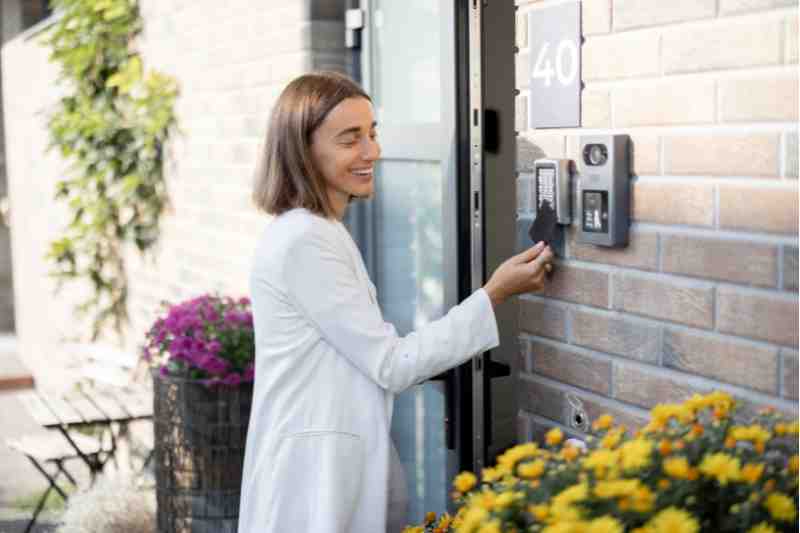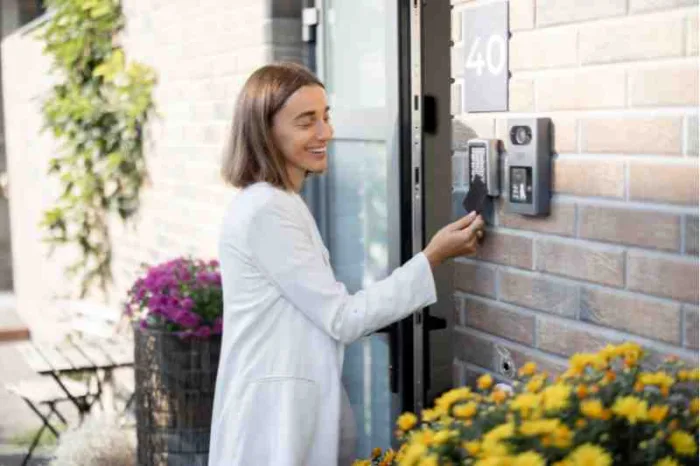Key takeaways
- The top three electronic latches offer enhanced security and convenience.
- Electronic latches are locks that disengage when they receive a short burst of electricity. They’re an integral part of many access control systems.
- Residents use electronic locks by scanning their credentials at a reader. Then, the controller verifies the credential, and the latch disengages.
- Electronic door locks are ideal for high-security areas because they stay locked during blackouts. For areas where you’re prioritizing convenience instead, you should consider
- installing magnetic locks that unlock during blackouts.

Every building’s access control system needs an electronic door release connected to the apartment intercom system that unlocks the door or gate and lets people in. And electronic latches are one of the most popular types of door release.
Read on to learn what an electronic door latch is and how it works. Then, discover where you should use electric latches on your property. Most importantly, learn what the best electronic latches are.
This post covers:
- 3 best electronic latches
- What is an electronic door latch?
- How does an electronic door latch work?
- Benefits of electronic door latches
- Electronic latch alternatives
3 best electronic latches
Electronic latches are intelligent locking mechanisms that offer a level of convenience and flexibility that traditional locks can’t match.
Whether you’re looking to bolster the security of your residence or enhance the efficiency of your commercial operations, electronic locks are a great solution.
Here’s our list of the best electronic door locks on the market:
1. Camlock Systems Series 400-R
Camlock Systems have a wide range of reliable electronic locks and latches that are compatible with any access control system.
Features:
- Simple to install. The universal fitting options make the Camlock Systems Series 400-R easy to install to any door or cabinet frame.
- Better security. Electronic door locks offer advanced security features, like access control, audit trails, and remote monitoring, to protect valuable assets and streamline access.
- Durability. The electric strike lock has a high-strength stainless steel construction that can withstand extreme force.
- Energy efficient. The Camlock Systems Series 400-R conserves power when not in use.
2. Von Duprin Latch Retraction Kit
Von Duprin’s quiet electric latch reduces noise – making it ideal for ambient environments like theaters, libraries, and hospitals.
Features:
- Heavy-duty traffic control solution. The Von Duprin latch retraction kit offers a durable latch that’s vandal-resistant.
- Panic and fire-rated. Von Duprin electric latches offer enhanced security measures that boost safety for room occupants.
- Can retrofit to existing devices. There’s no need to purchase extensive hardware because the latch can be ordered as a modular kit for existing devices.
- High-powered. Has a two amp power supply that enables longer wire runs from the power source.
3. Southco Rotary Latch
Southco Rotary Latch systems offer secure push-to-close convenience for any entry door.
Features:
- Wide range of designs. Southco Rotary latches provide a variety of mechanical and electromechanical offerings that are designed to suit any environment.
- Intuitive and easy to use. Has a user-friendly interface with Bluetooth smartphone-enabled technology.
- Audit trail. The cloud-based network logs events and allows you to access them from a single platform.
- Covers all your security needs. Provides keyless entry like RFID card readers that empower hands-free access.
What is an electronic door latch?
An electronic door latch, also known as an electric door strike, is a mechanical locking component installed in a doorframe that receives electric power to control when and how a door locks and unlocks.
In contrast to standard mechanical locks, electronic latches usually accept digital credentials like PIN codes or fobs instead of physical keys.
Before doors and locks had electronic capabilities, buildings used analog locks on doors. However, new access control hardware can pair with electronic door latches to provide more features and enable more ways to unlock the door.
You might use an electronic door latch with keyless lock control hardware like:
- Intercoms
- Card readers
- Keypads
- Fingerprint scanners
Are there different types of latches?
Yes, there are six different types of latches:
- Spring
- Slam
- Bolt
- Compression
- Cam
- Rotary
However, many of these different kinds of latches are used in contexts other than property access, like securing individual cabinets or automobiles.
To refer to latches when you’re talking about building access, you can also use the term “electric strike.” Electronic deadbolts, which extend and retract a bolt inside of a lock, also function very similarly to latches.
Where to install electronic latches
Electronic locks are great for many entrances, especially those with controlled access.
What’s more, electric latches are great for high-security areas because they stay locked during a blackout.
Because electronic latches stay locked and keep areas secure in an emergency, installers also refer to them as fail-secure locks.
Use an electronic door lock for areas like:
- Storage closets
- Server rooms
- IT rooms
How do you install an electronic door lock?
Electronic door locks are simple to install because they’re designed to replace traditional deadbolts. So, there’s no need to drill new holes or alter your door in any way.
What’s more, electronic door locks don’t require professional installation. So, you can opt to install them in-house.
How does an electronic door latch work?
An electronic door latch release works by releasing when it’s directed to by your access system’s controller after a user scans or enters an authorized credential.
The default state of electronic door latches is locked, and they only unlock for short periods. An electronic latch gets unlocked when it receives an electric current.
Electric door latch systems have these parts:
- Reader. Readers take the data from a resident’s credential and forward it over to the controller. Residents might enter a PIN, use a smartphone app, or scan an RFID or NFC card.
- Door latch controller. The controller serves as the “brains” of your access control system. Controllers usually manage multiple doors and latches across your property. When it receives credential data from the reader, the controller verifies your resident’s identity by checking it against the list of credentials in its database.
- Latch. The part of a door latch that moves is called a keeper. After the controller receives the signal, the keeper swings outward, and the resident can open the door.
When a controller wants to signal a latch to unlock, it does so by releasing a quick burst of electric current. After the latch unlocks for a set amount of time, it re-locks itself.
Watch an electronic latch in action:
Benefits of electronic door latches
Electronic door latches are a simple upgrade that offers more convenience to residents and staff alike. And when residents have a good experience navigating your property, they’re more likely to renew their leases.
Digital door latches also help you safeguard critical areas of your property during emergencies and power outages.
Here are some of the benefits of electronic latches:
- Using electronic credential readers like keypads and card readers
- Opening multiple doors with the same credential reader
- Delayed egress — allowing for a delay before a door is unlocked
- Setting schedules for doors to automatically lock and unlock
- Opening doors remotely with a smartphone app
Cons of electronic door locks
- Less durable. Over time, electronic components can wear out or become damaged, potentially leading to latch failure.
- Dependent on power. Most electronic latches rely on batteries or electrical power sources. So, if the power supply fails or the batteries die, the latch may not function adequately.
- Security concerns. Electronic latches can be vulnerable to hacking or tampering if not properly secured.
- Limited lifespan. Electronic latches don’t last the lifespan of the door and typically need to be replaced every five years.
Electronic latch alternatives
For every door on your property, you need to decide between maintaining high security or allowing quick access — and electronic latches emphasize security. So, you might not want to use an electronic latch on every single door on your property. What’s more, local fire codes might not permit that. So, make sure to research your local regulations before making any decisions.
Fortunately, there’s another electric option that you can install that pairs with access control systems without automatically locking: maglocks.
In contrast to electronic locks, maglocks require a constant stream of power. During a power outage, maglocks unlock — behavior you might want in areas with high foot traffic or areas where people need unimpeded access in an emergency.
As a result, you might use maglocks at:
- Rooftops
- Stairwells
- Lobbies







